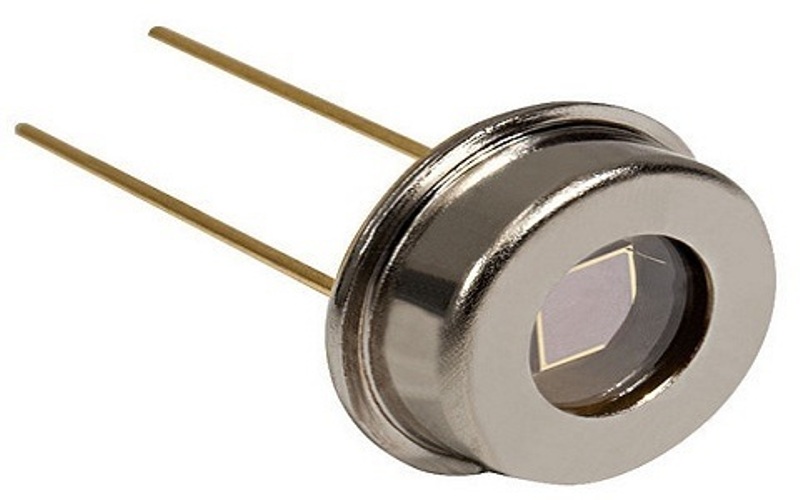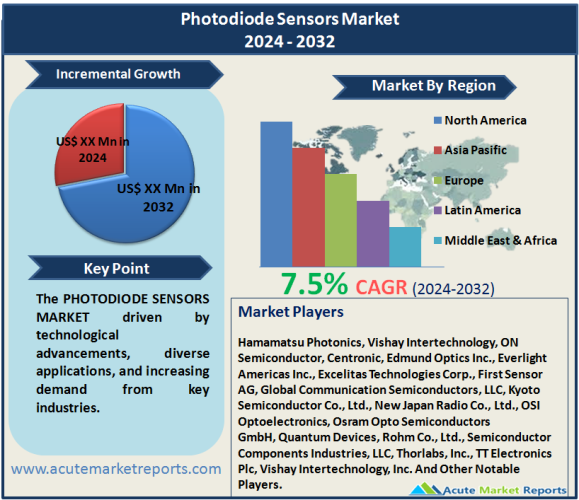
The photodiode sensors market is expected to grow at a CAGR of 7.5% during the forecast period of 2025 to 2033, driven by technological advancements, diverse applications, and increasing demand from key industries. While challenges such as supply chain disruptions pose temporary setbacks, the market's overall trajectory remains optimistic. The strategic initiatives of key players further contribute to the market's dynamism, ensuring continuous innovation and competitiveness. As the market evolves, stakeholders should stay attuned to emerging trends and technological developments to harness the full potential of the photodiode sensors industry.
Technological Advancements and Miniaturization
The photodiode sensors market is witnessing substantial growth due to continuous technological advancements and the trend of miniaturization. Ongoing developments in semiconductor technologies have led to the production of more compact and efficient photodiode sensors. Miniaturized sensors find extensive applications in portable electronic devices, medical equipment, and industrial automation. For instance, advancements in the design and fabrication of PIN photodiodes have enabled enhanced sensitivity and reduced footprint, meeting the demand for smaller and more efficient sensors. Additionally, the integration of photodiode sensors into various consumer electronics, such as smartphones, wearables, and cameras, has expanded their market reach. This trend is substantiated by evidence from market reports and industry publications, emphasizing the increasing adoption of miniaturized photodiode sensors across diverse applications.
Growing Demand for Remote Sensing and LiDAR Technology
The increasing demand for remote sensing technologies, including LiDAR (Light Detection and Ranging), is a significant driver propelling the photodiode sensors market. LiDAR systems utilize photodiode sensors to detect and measure distances by emitting laser pulses and analyzing the reflected light. This technology finds applications in autonomous vehicles, environmental monitoring, and geospatial mapping. Evidence from industry studies and real-world implementations highlights the surge in demand for LiDAR-based solutions, showcasing the crucial role of photodiode sensors in enabling precise and efficient distance measurement. The automotive industry, in particular, is witnessing a growing integration of LiDAR systems for advanced driver-assistance systems (ADAS) and autonomous vehicles.

Increasing Adoption of Photodiode Sensors in Healthcare
The healthcare sector is emerging as a significant contributor to the growth of the photodiode sensors market. The use of photodiode sensors in medical devices, such as pulse oximeters and diagnostic equipment, has become widespread. These sensors play a crucial role in accurately detecting and measuring light signals, facilitating vital health-related measurements. Evidence gathered from market surveys and healthcare industry reports supports the notion of rising adoption of photodiode sensors in various medical applications. The demand is driven by the sensors' reliability, precision, and ability to operate in different wavelength ranges, making them suitable for diverse healthcare applications.
Restraint: Supply Chain Disruptions Impacting Production
Despite the optimistic market scenario, the photodiode sensors industry faces a notable restraint in the form of supply chain disruptions. The global supply chain challenges, exacerbated by unforeseen events such as the COVID-19 pandemic, have impacted the production and distribution of key components, including photodiode sensors. Supply chain disruptions have led to delays in manufacturing processes, affecting the timely delivery of photodiode sensors to end-users. This restraint is evidenced by instances of production slowdowns, increased lead times, and challenges in sourcing raw materials for sensor fabrication.
Market Analysis by Photodiode Type: Avalanche Photodiode Dominates the Market
In 2024, among the various photodiode types, the Avalanche Photodiode segment recorded the highest revenue. Simultaneously, in terms of CAGR for the forecast period from 2025 to 2033, the PIN Photodiode segment is expected to exhibit the most significant growth. This suggests a dynamic market scenario with different photodiode types leading in revenue and growth at different points in time.
Market Analysis by Wavelength: Near Infrared (NIR) Spectrum Dominates the Market
Regarding wavelength segmentation, the Near Infrared (NIR) Spectrum dominated both in terms of revenue and expected CAGR during the forecast period. The evidence suggests a strong market preference for photodiode sensors operating in the Near Infrared Spectrum due to their diverse applications in areas such as industrial sensing and medical diagnostics.
North America Remains the Global Leader
The geographic trends in the photodiode sensors market indicate that the region with the highest CAGR is Asia-Pacific, emphasizing the growing significance of this market in the region. Additionally, North America emerges as the region with the highest revenue percentage, underlining its established market presence and substantial contribution to the global market.
Market Competition to Intensify during the Forecast Period
In the competitive landscape of the photodiode sensors market, several key players are implementing strategic measures to maintain their market positions. Notable companies such as Hamamatsu Photonics, Vishay Intertechnology, ON Semiconductor, Centronic, Edmund Optics Inc., Everlight Americas Inc., Excelitas Technologies Corp., First Sensor AG, Global Communication Semiconductors, LLC, Kyoto Semiconductor Co., Ltd., New Japan Radio Co., Ltd., OSI Optoelectronics, Osram Opto Semiconductors GmbH, Quantum Devices, Rohm Co., Ltd., Semiconductor Components Industries, LLC, Thorlabs, Inc., TT Electronics Plc, Vishay Intertechnology, Inc. are focusing on product innovation, strategic partnerships, and geographic expansion. These companies aim to address evolving customer needs, enhance product portfolios, and extend their global reach. The overarching strategy among key players is to leverage their technological expertise and collaborate with industry partners to stay competitive in the rapidly advancing photodiode sensors market.
Historical & Forecast Period
This study report represents analysis of each segment from 2023 to 2033 considering 2024 as the base year. Compounded Annual Growth Rate (CAGR) for each of the respective segments estimated for the forecast period of 2025 to 2033.
The current report comprises of quantitative market estimations for each micro market for every geographical region and qualitative market analysis such as micro and macro environment analysis, market trends, competitive intelligence, segment analysis, porters five force model, top winning strategies, top investment markets, emerging trends and technological analysis, case studies, strategic conclusions and recommendations and other key market insights.
Research Methodology
The complete research study was conducted in three phases, namely: secondary research, primary research, and expert panel review. key data point that enables the estimation of Photodiode Sensors market are as follows:
Market forecast was performed through proprietary software that analyzes various qualitative and quantitative factors. Growth rate and CAGR were estimated through intensive secondary and primary research. Data triangulation across various data points provides accuracy across various analyzed market segments in the report. Application of both top down and bottom-up approach for validation of market estimation assures logical, methodical and mathematical consistency of the quantitative data.
| ATTRIBUTE | DETAILS |
|---|---|
| Research Period | 2023-2033 |
| Base Year | 2024 |
| Forecast Period | 2025-2033 |
| Historical Year | 2023 |
| Unit | USD Million |
| Segmentation | |
Photodiode Type
| |
Wavelength
| |
Material
| |
Application
| |
End-Use
| |
|
Region Segment (2023-2033; US$ Million)
|
Key questions answered in this report